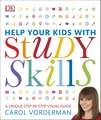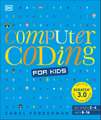Help Your Kids with Maths, Ages 10-16 (Key Stages 3-4): A Unique Step-by-Step Visual Guide, Revision and Reference: DK Help Your Kids With
Autor Carol Vordermanen Limba Engleză Paperback – iul 2014
Preț: 100.95 lei
Nou
Puncte Express: 151
Preț estimativ în valută:
19.32€ • 20.10$ • 15.95£
19.32€ • 20.10$ • 15.95£
Cartea se retipărește
Doresc să fiu notificat când acest titlu va fi disponibil:
Se trimite...
Preluare comenzi: 021 569.72.76
Specificații
ISBN-13: 9781409355717
ISBN-10: 1409355713
Pagini: 264
Ilustrații: illustrations (colour)
Dimensiuni: 201 x 241 x 17 mm
Greutate: 0.83 kg
Editura: Dorling Kindersley - DK
Colecția DK
Seria DK Help Your Kids With
Locul publicării:London, United Kingdom
ISBN-10: 1409355713
Pagini: 264
Ilustrații: illustrations (colour)
Dimensiuni: 201 x 241 x 17 mm
Greutate: 0.83 kg
Editura: Dorling Kindersley - DK
Colecția DK
Seria DK Help Your Kids With
Locul publicării:London, United Kingdom
Notă biografică
Carol Vorderman, one of Britain's best known and loved TV personalities, feels passionately about the value of education. Carol joined forces with DK in 1999 to become DK's Education Champion and has helped them to build the bestselling "Made Easy" series, which includes topics in maths, English, and science and technology. She has also encouraged parents and their teenage children to work together in the "Help Your Kids" series, which includes Help Your Kids With Science and Help Your Kids With English. Versatile as ever, Carol has also provided an accessible and fun entry into the world of computer programming with Computer Coding Projects For Kids.
Cuprins
- 1: Foreword
- 2: Introduction
- 3: Numbers
- 1: Introducing numbers
- 2: Addition
- 3: Subtraction
- 4: Multiplication
- 5: Division
- 6: Prime numbers
- 7: Units of measurement
- 8: Telling the time
- 9: Roman numerals
- 10: Positive and negative numbers
- 11: Powers and roots
- 12: Surds
- 13: Standard form
- 14: Decimals
- 15: Binary numbers
- 16: Fractions
- 17: Ratio and proportion
- 18: Percentages
- 19: Converting fractions, decimals, and percentages
- 20: Mental maths
- 21: Rounding off
- 22: Using a calculator
- 23: Personal finance
- 24: Business finance
- 4: Geometry
- 1: What is geometry?
- 2: Tools in geometry
- 3: Angles
- 4: Straight lines
- 5: Symmetry
- 6: Coordinates
- 7: Vectors
- 8: Translations
- 9: Rotations
- 10: Reflections
- 11: Enlargements
- 12: Scale drawings
- 13: Bearings
- 14: Constructions
- 15: Loci
- 16: Triangles
- 17: Constructing triangles
- 18: Congruent triangles
- 19: Area of a triangle
- 20: Similar triangles
- 21: Pythagoras’ theorem
- 22: Quadrilaterals
- 23: Polygons
- 24: Circles
- 25: Circumference and diameter
- 26: Area of a circle
- 27: Angles in a circle
- 28: Chords and cyclic quadrilaterals
- 29: Tangents
- 30: Arcs
- 31: Sectors
- 32: Solids
- 33: Volumes
- 34: Surface area of solids
- 5: Trigonometry
- 1: What is trigonometry?
- 2: Using formulas in trigonometry
- 3: Finding missing sides
- 4: Finding missing angles
- 6: Algebra
- 1: What is algebra?
- 2: Sequences
- 3: Working with expressions
- 4: Expanding and factorizing expressions
- 5: Quadratic expressions
- 6: Formulas
- 7: Solving equations
- 8: Linear graphs
- 9: Simultaneous equations
- 10: Factorizing quadratic equations
- 11: The quadratic formula
- 12: Quadratic graphs
- 13: Inequalities
- 7: Statistics
- 1: What is statistics?
- 2: Collecting and organizing data
- 3: Bar charts
- 4: Pie charts
- 5: Line graphs
- 6: Averages
- 7: Moving averages
- 8: Measuring spread
- 9: Histograms
- 10: Scatter diagrams
- 8: Probability
- 1: What is probability?
- 2: Expectation and reality
- 3: Combined probabilities
- 4: Dependent events
- 5: Tree diagrams
- 9: Reference section
- 10: Glossary
- 11: Index
- 12: Acknowledgements















